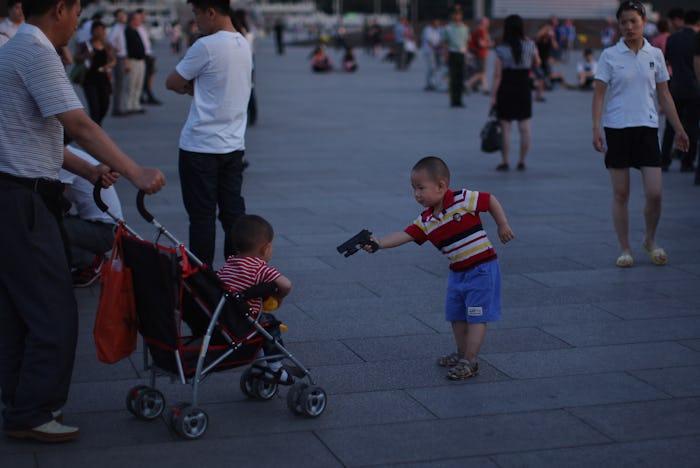News

Parents Think Their Kids Can Tell Real & Toy Guns Apart, But A New Survey Found Different
Over time, the look of toy guns has altered, with many of them becoming incredibly realistic. Now, there's a lot of toy guns on the market that look almost indistinguishable from real guns. So, how do kids tell which is which? According to a new survey, kids don't know the difference between real and toy guns. That's obviously dangerous, but it's not the most shocking thing this survey found.
Toys guns have become a regular topic of debate as many people wonder how safe it is to normalize playing with kids. For many, toy guns pose real concerns when it comes to accidental shootings. According to Everytown, research shows that about 4.6 million American children live in homes with at least one gun that's loaded and unlocked. Everytown notes that there have been at least 999 unintentional shootings by children since 2015, with 391 of them resulting in death.
Retailers have received pushback in the past around selling super realistic toy guns. In 2015, NBC News reported that online retailers illegally selling toy guns through third party platforms, like Amazon, had agreed to abandon the practice. Two years later, Walmart also banned the sales of toys guns.
The debate around toy guns may seem excessive. What kid is going to mistake a real gun for a toy, after all? Using a convenience sample of people who presented at three pediatric emergency departments, a few researchers decided to look into just that.
Researchers worked with 297 pairs of children and caregivers, as reported by Science Daily. According to Med Page Today, 196 were recruited from emergency departments in suburban hospitals and 101 from one urban emergency department.
Of the sample presented, Med Page Today reported that between 53 to 74 percent of caregivers believed their child could discriminate between real and toy guns, as did 68 percent to 88 percent of the children.
However, when asked to identify between a real gun or a fake, less than half of the children could do so. According to Pediatric News, 39 percent of the gun owners' children and 42 percent of the non-gun owners' children correctly pointed out the real gun.
Kiesha Fraser Doh, who conducted the study, said, according to Science Daily:
One of the most dramatic findings was how easily caregivers and children can confuse real guns with today's realistic-looking toy guns. Especially considering gun owners surveyed were nearly twice as likely as non-gun owners to let their children play with toy guns, safe storage of firearms in homes where children play is critical.
In addition, researchers made one other important discovery. Although only 5 percent of caregivers felt their child could obtain a gun within 24 hours, according to Pediatric News, results showed otherwise. Pediatric News reported that 14 percent of children whose caregivers owned a gun and 4 percent of children whose caregivers didn't, said they could access a gun within a day.
"If you think about it, the majority of parents are storing their firearms insecurely, and the children cannot tell the difference between a real gun and a toy firearm," Fraser Doh noted, according to Med Page Today, adding:
What this study tells us is that it behooves pediatricians to continue to educate their families on how to store firearms safely, and is a reminder to parents to check on how firearms are being stored in homes where their children are visiting.
If you do have guns in the same home as children, Project ChildSafe notes a few key guidelines for safe storage. First, all guns should be unloaded and stored in a locked cabinet, safe, gun vault, or storage case that's inaccessible to children. Additionally, ammunition should be stored in a locked location separate from the guns and all firearms should be double checked to confirm they're unloaded when removed from storage, according to Project ChildSafe.
As toy guns get more realistic, it's harder for kids to tell the difference, as this survey showed. It's time to start holding real conversations about gun safety, with both kids and adults.